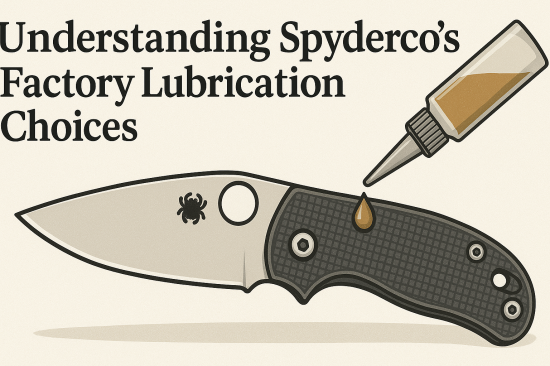Understanding Spyderco’s Factory Lubrication Choices

By Logan M. Fraser – Custom Knife Modder & Spyderco Parts Specialist, Based in Calgary, Alberta, Canada
This is the 15th blog of the Spyderco Knife blog series. You can check the other blogs I’ve written here: https://spydercoparts.com/blogs
If you’ve ever disassembled a Spyderco knife straight out of the box, you may have noticed traces of grease or oil near the pivot or lock areas. That leads many users to ask: “What kind of lubricant does Spyderco use from the factory?” And just as importantly—should you keep it or clean it out?
In this post, we’ll break down Spyderco’s factory lubrication strategy, what it means for knife performance, and how to make informed maintenance choices based on real-world use.
Why Lubrication Matters in Folding Knives 
Lubrication reduces friction between the pivot, washers, and lock surfaces. It helps:
Smooth out deployment
Prevent wear on steel-on-steel contact
Protect against rust and moisture
But not all lubes are created equal—and how much is used can vary depending on model, production batch, and intended use.
What Lubricant Does Spyderco Use at the Factory? 
Spyderco has used various lubricants over the years, but the two most common are:
1. Petroleum-Based Grease (Clear/Light Tan)
Often found on:
Lockback knives like the Endura, Delica, Native
Salt series knives with H-1 or LC200N steel
This grease offers corrosion resistance, especially for models exposed to saltwater or humid conditions.
2. Light Oil (Clear Viscous Fluid)
Seen on:
Compression lock knives like the PM2, Para 3, Sage 5
Liner/frame locks and bearing-based models
Used to enhance smoothness and support break-in of tight tolerances.
Spyderco has not publicly disclosed specific brands, but based on scent, color, and consistency, it’s likely a neutral light mineral oil or a non-toxic food-grade equivalent in some models.
Should You Clean It Out? 
As a modder, here’s my take:
Leave it alone if the action is good
Clean it out if it feels gritty, sticky, or over-lubed
If you’re planning to disassemble and mod, start with a clean pivot and use your preferred lubricant
I recommend:
KPL (Knife Pivot Lube) for general use
Tuf-Glide or BreakFree CLP for corrosion-prone environments
Special Note on Salt Series 
The Salt Series (especially older H-1 models) often comes heavily greased. That’s intentional:
It helps preserve parts during shipping/storage
Many of these are carried in marine or high-humidity settings
You can wipe away excess and reapply something lighter like KPL Light if you prefer snappier action—but don’t go dry.
Lubrication Tips for Spyderco Owners 
Use only a drop or two per side of the pivot
Clean the blade tang and lock faces during disassembly
Avoid over-oiling the detent ball—too much attracts lint
Use a Q-tip or lint-free swab to reach nested parts
Want Maintenance-Friendly Hardware? 
If you’re doing regular maintenance or mods, using high-precision hardware helps. We stock replacement screws, pivots, and backspacers at https://spydercoparts.com, all tested for fitment on real Spyderco models.
We also keep parts in raw stainless and coated finishes to match different blade styles and environments.
Where to Learn More 
https://spyderco.com: Their knife care guide covers basic maintenance philosophy
https://forum.spyderco.com: Community feedback on lubricants, mods, and long-term effects of factory grease vs. oil
These are solid resources if you’re curious how long-term users treat their knives post-unboxing.
Final Thoughts 
Spyderco’s factory lubrication choices are designed for durability, not slickness. In most cases, they’re aiming to protect knives across transit, humidity, and storage conditions worldwide.
Whether you leave the grease or upgrade to your preferred oil, a little understanding goes a long way in keeping your blade dialed in.
Got a question about factory lube, maintenance, or your favorite oil setup? Drop it in the comments below. And let me know what you want covered in next week’s Spyderco Knife Blog Series.

